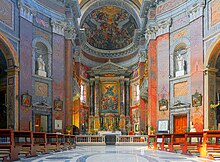San Giacomo in Augusta
| San Giacomo in Augusta St. Jerome in Augusta (English) Sancti Iacobi in Augusta (Latin) |
|
|---|---|
 |
|
| Basic information | |
| Location | Rome, Italy |
| Affiliation | Roman Catholic |
| Leadership | Chibly Langlois |
| Architectural description | |
| Architect(s) | Francesco da Volterra and Carlo Maderno |
| Architectural type | Church |
| Architectural style | Baroque |
| Groundbreaking | 14th century |
| Completed | 1600 |
San Giacomo in Augusta is a Baroque-style church built in central Rome, Italy.
Standing on Via del Corso number 499, roughly three blocks south of the Piazza del Popolo in rione Campo Marzio, nearly opposite to the church of Gesù e Maria. A Church at the site was originally built in the 14th century adjacent to a hospital for the Incurabili (uncurables), and thus is also known as San Giacomo degli Incurabili. The suffix ‘’in Augusta’’ referred to the neighboring Mausoleum of Augustus.
A church at the location was founded along with a hospital by Cardinal Giovanni Colonna in 1339. By 1515, the hospital was in a state of abandon, but within a few decades reopened under the supervision of two religious orders, with the aim of curing those affected by syphilis. Pope Nicholas V placed it under the control of the Company of Santa Maria del Popolo. This order was under the patronage of the Florentine Cardinal Antonio Maria Salviati, and he commissioned the reconstruction of the church. The oval layout of the church at the site was rebuilt starting by Francesco da Volterra in 1592. Upon the former architect's death, the facade and most of the interior decoration completed by Carlo Maderno in 1600.
The interior contains a bas relief of St Anthony of Padua and the Virgin interceding for the Ill by Pierre Le Gros the Younger on the second chapel. On the side walls are large paintings by Giuseppe Passeri.
The altar in the first chapel on the right has a Resurrection painted by the mannerist painter Cristoforo Roncalli. In the second chapel on the right is a marble bas-relief by Le Gros representing St Francesco di Paola in Prayer. Le Gros also helped complete the nave stucco work.
...
Wikipedia
